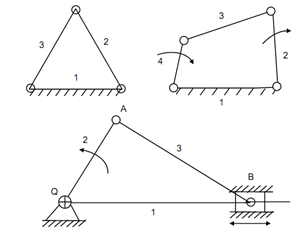Planar Mechanism:
A mechanism may be defined as a closed kinematic chain in which one link is set. The kinematic chain that forms a mechanism must have constrained motion. It means that a definite motion of any link generate unique motion of all of other links. In other terms, the relative position of any one link exclusively defines the relative position of a point on any other link.
Before going into the broad theory of mechanisms it can be observed that to form a simple closed chain we require at least three links along three kinematic pairs. If any one of these three links is fixed, there may not be relative movement and, thus, it does not make a mechanism however it becomes a structure that is completely rigid. Therefore, a simplest mechanism contains four links, each connected by a kinematic lower pair (revolute etc.), and it is called as four bar mechanism.

Planar Mechanism
For instance, reciprocating engine mechanism is a planner mechanism in this link 1 is fixed, link 2 rotates and link 4 reciprocates. In internal combustion engines, it changes reciprocating motion of piston to rotating motion of crank. This mechanism is also utilized in reciprocating compressors in which it change rotating motion of crank into reciprocating motion of piston. It was a very common practical instance and there are many other instances like this. More about planar mechanisms will follow in next units.